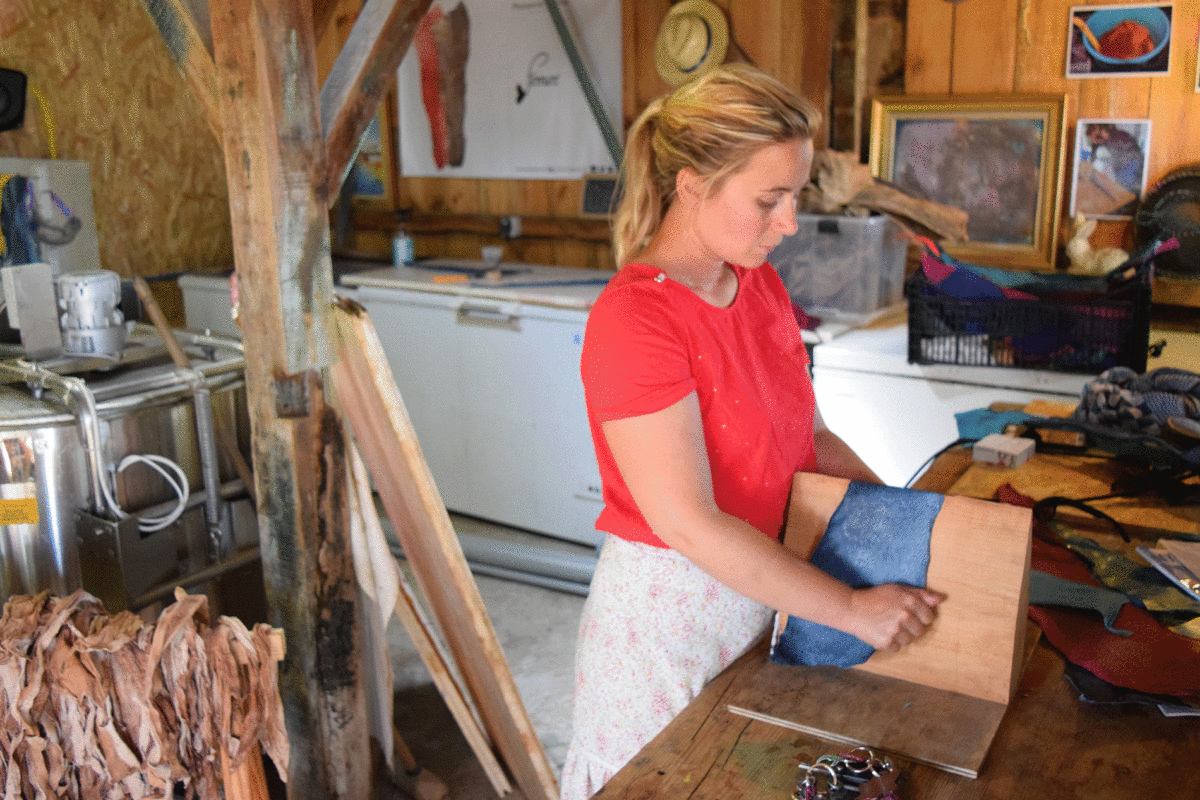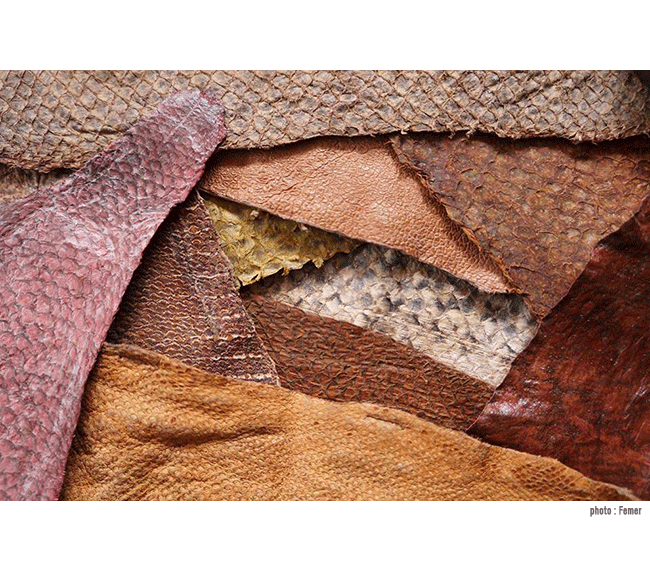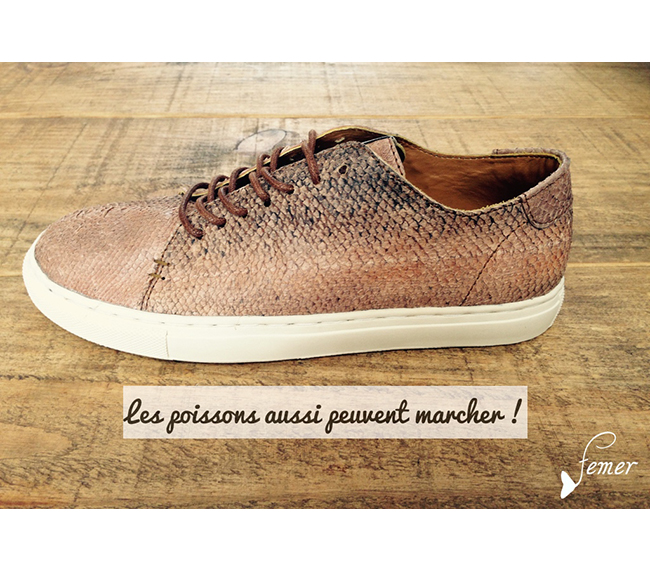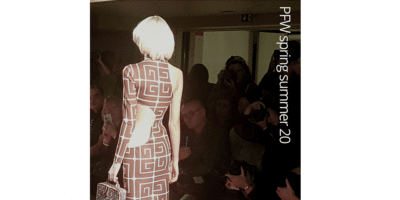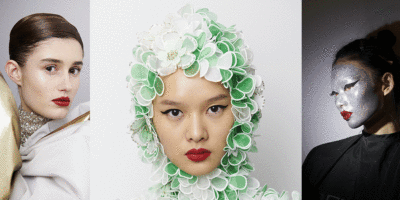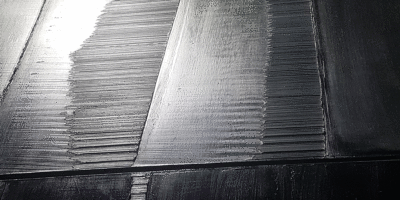Today is the day to celebrate an artisanal know-how at the core of an emerging company that roots its brand story in the philosophy of sustainable life. I’ve recently discovered the local do-gooder French enterprise, Femer, embarking on its ground breaking project: setting the fish leather industry on a new Eco-friendly course in the Aquitaine region, near Bordeaux, France.
In parallel to the UN Climate Change Conference in Paris, the capital of fashion hosted many events tackling issues related to fashion and sustainability indeed. And I enthusiastically met with Femer’s founder, Marielle Philip, who shared her own story during the B to B round-table on leather and sustainability organized for fashion professionals by the Maison du Savoir-Faire et de la Création, drived by the Groupement de la Fabrication Française (GFF) and hosted by the Fédération Française du Prêt à Porter Féminin (FFPAPF).
The tanning is 100% natural. Marielle Philip explains that she uses vegetable tanning agents as the widely available mimosa and not the widely used quebracho. Why is that? Quebracho may be used for efficient vegetable tanning but is responsible for deforestation in Latin America, the graduate in Law Environment points out. Coherence in the sustainable business is needed. The idea: building a sustainable and ethical supply chain “from the fisherman to the handbag” by gathering people who would never meet otherwise.
To that end, not only does Femer recycle waste from the fishing industry but it recycles its own waste as well:
– rest of fish meat can be used as fish bait. The fish somehow goes back to the ocean.
– fish scales can be used, upcycled and reinvented by fashion designers, especially jewelry designers.
– leftovers from fish leather skin can be used as compost by local businesses in Aquitaine.
Salmon, trout, bass, sole, skate, monk-fish, sturgeon… Well, the variety of eyes-catching fish leather skins available is quite enormous, and upcycling the skins of fishes we eat obviously does make sense in the circular economy praised by the entrepreneur born and raised in the littoral coast of France, where she opted for a hands-on style of entrepreneurship and seized the opportunity to wave the fabric of the inspiring fable of Femer.
At the beginning : Marielle Philip’s mother discovered the traditional know-how of fish leather. Years ago, in 2003, her mother went on a trip to Lapland where she bought a salmon leather coat. That was her daughter’s first contact with fish leather. Later, fresh on the heels of the completion of her Master of Environmental Law and Integrated Coastal Area Management and faced with unemployment, Marielle finally decided to get self-employed and created her own company a year ago. She’s always wanted to have her own company, she says, it’s just happened before expected.
For now, only 1000 fish leather skins per year are provided. For twenty euros or so, a fish leather skin can be bought. They are easily assembled, the founder adds. Today, Femer collaborates with fashion brands on R&D. Marielle’s mother, Monique, is part of the adventure as well. It’s a family-run business made of two units: a fisherman cabin at La Teste-de-Buch and an office supported by the Bordeaux-based business incubator Darwin, focused on start-ups involved in the circular economy and innovation by sustainable and collaborative initiatives. To this day, Femer won a couple of awards granted by regional and national French business actors.
All in all, neither the quality of the product nor its availability are the biggest challenges for the entrepreneur, but the poor brand image of fish leather generally speaking is : fashion leather skins don’t make people dream (yet!)… And providing Femer’s audience with dreams is key within the high-end fashion industry and luxury business it targets, especially interior yacht design, besides the shoe-making and glove-making industries and other leather goods.
Fish leather remains a tough sell pregnant with all kinds of prejudices, Marielle regrets. No, fish leather don’t smell bad! It is an ancestral know-how that still is perpetuated today, and that you must have closely looked at if you’ve ever been to Island. Even though other parts of the world in Australia, China, Thailand or Brazil do create fisher leather, there has never been an attempt at structuring the industry on the wide scale. Which seems quite surprising. As Marielle says: “I’d prefer to catch a fish rather than a snake or crocodile!” Femer brings back common sense in the fashion and design business as well, and it feels good, doesn’t it?
In January 2016, a new color palette is expected with punchy colors as red.
It is to bet that time will come when looking at fish leather with today’s fresh eyes will change our perception of the underestimated ancestral tradition: don’t we love the idea of wearing fashion that values all human endeavors undertaken with newness, vision and a nod to sustainable concerns?
For information about the Daily Couture’s Paris haute couture private tours organized all year round (except August), visit our page dedicated to our Paris bespoke Haute Couture and Sur Mesure tours for professionals and private individuals interested in discovering this confidential world of French fashion, don’t hesitate reading our Guest Book and contact The Daily Couture : Stéphanie Bui – info@thedailycouture.com

